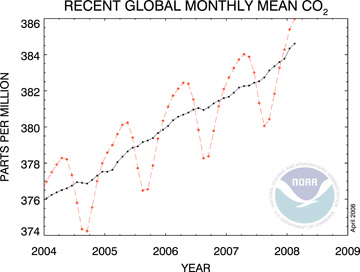Carbon dioxide levels at highest level in 800,000 years
Carbon dioxide levels at highest level in 800,000 years
mongabay.com
May 29, 2008
|
|
Greenhouse gases are at the highest levels in the past 800,000 years according to a study published in the journal Nature.
Analyzing carbon dioxide and methane trapped in tiny air bubbles up to 10,000 feet below the surface of Antarctica, an international team of researchers extended the 650,000-year climate record back another 150,000 years.
The study also uncovered a new low for the atsmopheric concentration of carbon dioxide: 172 parts per million (ppm) some 667,000 years ago, about 10 ppm below the previous known low.
The research suggests a natural range for CO2 levels of 172 to 300 ppm, lending support for the belief that industrial emissions of greenhouse gases have pushed carbon dioxide levels outside their recent historical range.
 The 2007 rise in global carbon dioxide (CO2) concentrations is tied with 2005 as the third highest since atmospheric measurements began in 1958. The red line shows the trend together with seasonal variations. The black line indicates the trend that emerges when the seasonal cycle has been removed. (Credit: NOAA) |
Carbon dioxide levels presently stand at 385 ppm, or about 38 percent higher than pre-industrial levels, according to NOAA.
The Intergovernmental Panel on Climate Change (IPCC) projects that atmospheric carbon dioxide levels could reach 450-550 ppm by 2050, resulting in higher temperatures and rising sea levels.
Environmenalists have recently launched a campaign targeting a global CO2 concentration of 350 ppm, a level which they say will avoid the worst impacts of global warming.
High-resolution carbon dioxide concentration record 650,000-800,000 years before present. Dieter Lüthi, Martine Le Floch, Bernhard Bereiter, Thomas Blunier, Jean-Marc Barnola, Urs Siegenthaler, Dominique Raynaud, Jean Jouzel, Hubertus Fischer, Kenji Kawamura & Thomas F. Stocker. Nature 453, 379-382 (15 May 2008) doi:10.1038/nature06949